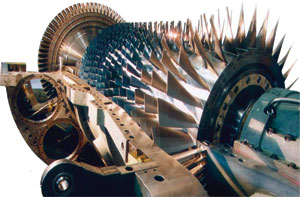 Technology from Europe: Technology from Europe:
Italy
Demanding field project – demanding compressors
Kashagan oil field lies in the shallow waters of the North Caspian Sea, off the coast of Kazakhstan. It is one of the most challenging fields in the world and, with 13 billion bbl of reserves, ranks among a handful of giants. Pressures there are up to 15,000 psi, with an H2S content that averages 18 to 20%, and can reach 33%.
The field is scheduled to begin production in 2008, with expected output to ramp up to 1.2 million bopd by 2020. There are many daunting obstacles that needed to be overcome by operator field Agip and its partners. The oilfield lies in 30 ft of water, yet is 38 mi offshore. Nevertheless, there are strong currents, waves and temperature extremes of – 37°F in winter, with moving sea ice, and 104°F in summer, and a unique environment that requires stringent environmental protection measures.
Agip and its partners have decided on gas reinjection to accomplish three things: maintain reservoir pressure, avoiding massive sulphur production and eliminate flaring of sweetened gas and consequent carbon dioxide production. Based in Florence, Italy, GE Oil & Gas is helping to meet the operator’s gas re-injection needs. The company acquired compressor manufacturer Nuovo Pignone in 1994 and has considerable experience with custom requirements. The re-injection project will require a design pressure of 13,250 psi. Discharge pressures of up to 11,020 psi are required, which are the highest pressures ever demanded for gas re-injection.
The new GE centrifugal compressors will be three-stage, with three-casing units. Corrosion-resistant chromium-molybdenum alloy will be used for the casings and process pipework to protect against the sour gas.
Each gas train will be designed to inject 5.4 MMcfd of sour gas, each driven by a 30-MW turbine. Besides the turbocompression trains, GE will manufacture interstage air coolers and the reciprocating compressors, which are used to boost seal gas and the antisurge valves in the centrifugal compressors. Nitrogen will be used to buffer and seal the casings. Leaks of any kind are not permissible and could be deadly.
The company recently completed tests for what will be the world’s highest pressure gas re-injection train. Based on well-proven re-injection train architecture that incorporates a double-shaft GE Frame, 5-2D gas turbine, and three centrifugal compressors, the turbo-compression train reached 820 bar pressure during full density tests, topping the former record of 690 bar, also achieved by GE technology.
The tests included 1,050-bar pressure capability (15,230 psi) of the casing used for the BCL304/E centrifugal compressor. Hydraulic testing of this compressor showed capability up to 19,870 psi, which is 1.5 times the required design pressure.
Other highlights included:
- Highest gas density ever reached, nearly 500 kg/m3 (25 MW test gas mixture with methane and carbon dioxide)
- Casing zero-leakage system was successful validated during the full-load test. This will ensure no sour gas ambient emission during site operation, where H2S content may reach 33%
- Testing on the highest pressure casing at full-load, full-density conditions yielded absorbed power that is 10% below the predicted values stated in the contract data sheets, with vibration level staying below 10 microns (7 microns at 11,900 bar vs. 38 microns allowed)
- Full operability along the entire operating range of the re-injection train, with no aero excitation.
 |
Record-setting compressors for Kashagan.
|
|
All of the compressors were first tested separately in GE’s Oil & Gas facilities in Florence, Italy, followed by tests for the entire, assembled train at GE’s plant in Massa, Italy, at full-density, full-speed, full-pressure and full-power conditions, according to the ASME Type I test requirements.
The trains will be mounted on twin barges, each 311 ft long, 52 ft wide and 18 ft high, now under construction in La Spezia, Italy. If all goes as planned, by fall of 2006, the barges will be towed through the Mediterranean and Black Seas headed for the Caspian. AS many as 10 might eventually be required. 
|

 Technology from Europe:
Technology from Europe:

